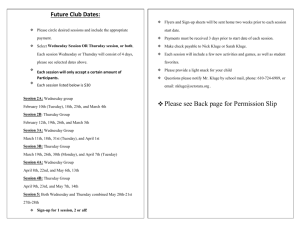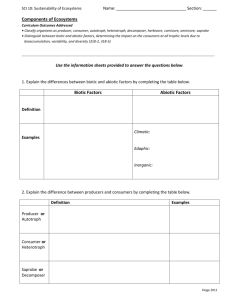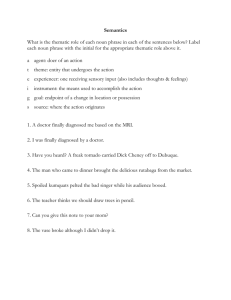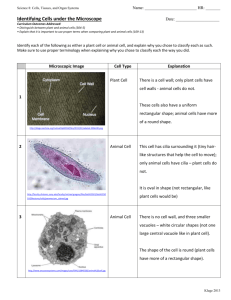dkproIntroCore
advertisement
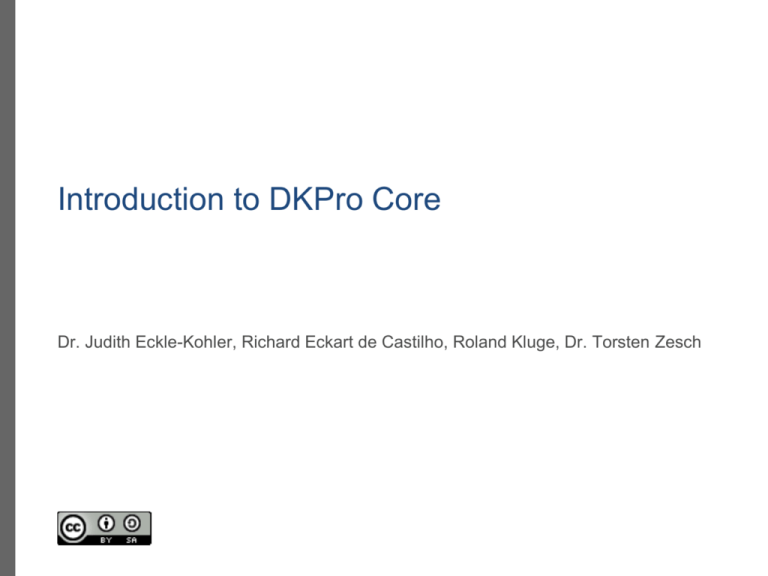
Introduction to DKPro Core
Dr. Judith Eckle-Kohler, Richard Eckart de Castilho, Roland Kluge, Dr. Torsten Zesch
Part 1: Tools in DKPro-Core
29.05.2013 | Dr. J. Eckle-Kohler, R. Eckart de Castilho, R. Kluge, Dr. T. Zesch
2
Analysis Levels in Text Processing
unstructured
Segmentation
Morphology
Syntax
Semantics
structured
29.05.2013 | Dr. J. Eckle-Kohler, R. Eckart de Castilho, R. Kluge, Dr. T. Zesch
3
UIMA Example Pipeline for Text Processing
Collection Reader
CAS
Segmentation
Morphology
Syntax
Semantics
Segmenter
CAS
POS Tagger
CAS
Named Entity Rec.
CAS
CAS Consumer
29.05.2013 | Dr. J. Eckle-Kohler, R. Eckart de Castilho, R. Kluge, Dr. T. Zesch
4
Overview of Tools and Formats
Integrated Tools
Supported Formats
• TreeTagger
• Text
• OpenNLP
• PDF
• Stanford NLP
• TEI XML, BNC XML
• JWordSplitter
• Negra Export
• Language Tool
• SQL Databases
• MaltParser
• Google web1t n-grams
•…
•…
See also: http://code.google.com/p/dkpro-core-asl/
(list of important ASL / GPL components)
29.05.2013 | Dr. J. Eckle-Kohler, R. Eckart de Castilho, R. Kluge, Dr. T. Zesch
5
Overview of Tools and Formats – Sources
• Javadocs created by the DKPro-Core ASL Jenkins:
https://zoidberg.ukp.informatik.tu-darmstadt.de/jenkins/job/DKPro Core ASL
• Overview of models in DKPro Core:
see http://code.google.com/p/dkpro-core-asl/wiki
• Checkout DKPro Core in eclipse and browse the modules
• The test classes provide important information on how to use the
components
29.05.2013 | Dr. J. Eckle-Kohler, R. Eckart de Castilho, R. Kluge, Dr. T. Zesch
6
DKPro Core Type System
• Why does DKPro Core specify UIMA types for linguistic annotations?
• Convenient access to linguistic annotations
for (N noun : JCasUtil.select (jcas, N.class)) {
…
}
• See graphical overview of the most important types:
• http://code.google.com/p/dkpro-core-asl/wiki/TypeSystem
• Where to find the DKProType System in the code, i.e., in the dkpro-core-asl
modules?
• de.tudarmstadt.ukp.dkpro.core.api.*
• TypeName.java and TypeName_Type.java
29.05.2013 | Dr. J. Eckle-Kohler, R. Eckart de Castilho, R. Kluge, Dr. T. Zesch
7
UIMA type mappings – example POS tags
• Tags mapped to UIMA types (configurable)
• To be found in src/main/resources, files named *.map
• Generic: Original tags stored in a value feature, e.g. POS.value
• Coarse Grained: Currently supported for Part-of-Speech tags
• 13 coarse grained part-of-speech tags
• ADJ, ADV, ART, CARD, CONJ, N (NP, NN), O, PP, PR, V, PUNC
• Convenient coarse-grained processing across languages
• Similar “Universal Part-of-Speech” tag-set published @ LREC 2012
• Slav Petrov, Dipanjan Das and Ryan McDonald
• Defines mappings for 25 tagsets in 22 languages
• Will be adopted for DKPro Core in the future
29.05.2013 | Dr. J. Eckle-Kohler, R. Eckart de Castilho, R. Kluge, Dr. T. Zesch
8
Use of managed dependencies
<dependencyManagement>
…
<dependency>
<groupId>de.tudarmstadt.ukp.dkpro.core</groupId>
<artifactId>de.tudarmstadt.ukp.dkpro.core-asl</artifactId>
<version>1.4.0</version>
<type>pom</type>
<scope>import</scope>
</dependency>
…
</dependencyManagement>
29.05.2013 | Dr. J. Eckle-Kohler, R. Eckart de Castilho, R. Kluge, Dr. T. Zesch
9
Readers for many formats
• Where to find readers in dkpro-core?
• de.tudarmstadt.ukp.dkpro.core.io.*
• Example TextReader
• Good to know: use this as a template, if you need to implement your own
reader for any specific format
<dependency>
<groupId>de.tudarmstadt.ukp.dkpro.core</groupId>
<artifactId>de.tudarmstadt.ukp.dkpro.core.io.text-asl</artifactId>
</dependency>
29.05.2013 | Dr. J. Eckle-Kohler, R. Eckart de Castilho, R. Kluge, Dr. T. Zesch
10
Adding Models as managed dependencies, e.g. TreeTagger component
<dependency>
<groupId>de.tudarmstadt.ukp.dkpro.core</groupId>
<artifactId>de.tudarmstadt.ukp.dkpro.core.treetagger-asl</artifactId>
</dependency>
<dependency>
<groupId>de.tudarmstadt.ukp.dkpro.core</groupId>
<artifactId>de.tudarmstadt.ukp.dkpro.core.treetagger-bin</artifactId>
</dependency>
<dependency>
<groupId>de.tudarmstadt.ukp.dkpro.core</groupId>
<artifactId>de.tudarmstadt.ukp.dkpro.core.treetagger-model-de</artifactId>
</dependency>
<dependencyManagement>
…
<dependency>
<groupId>de.tudarmstadt.ukp.dkpro.core</groupId>
<artifactId>de.tudarmstadt.ukp.dkpro.core.treetagger-asl</artifactId>
<version>1.4.0</version>
<type>pom</type>
<scope>import</scope>
</dependency>
…
</dependencyManagement>
29.05.2013 | Dr. J. Eckle-Kohler, R. Eckart de Castilho, R. Kluge, Dr. T. Zesch
11
Part 2: Linguistic annotation –
Basics
29.05.2013 | Dr. J. Eckle-Kohler, R. Eckart de Castilho, R. Kluge, Dr. T. Zesch
12
Tokenization and sentence splitting – Ambiguities
Period
• In most of the cases: Final sentence punctuation symbol
• Part of an abbreviation, e.g. F.D.P.
• Numbers, ordinal numbers, e.g.: 21., numbers with fractions, e.g. 1.543
• References to resources locators, e.g.: www.apple.com
• To complicate things, if a sentence ends with an abbreviation which
ends with a period, only one period is written. “He lives at Lakeview Dr.”
•…
Whitespace character
• Part of numbers, e.g. “1 543”
• No segmentation character in multi-word expressions “New York”
29.05.2013 | Dr. J. Eckle-Kohler, R. Eckart de Castilho, R. Kluge, Dr. T. Zesch
13
Tokenization and sentence splitting – Ambiguities
Comma
• Part of numbers, e.g. 1,543
Single quote
• Within tokens to mark contractions and elisions, e.g. English: don’t,
won’t, you’ve, James’ new hat; German: Ich hab’s!
• Part of a token in French, e.g. aujourd´hui
• But in most cases: Enclosing quoted groups of words
Dash
• A delimiter, if it connects strings of digits, e.g. "see page 100-101”
• In French: Signal a close connection between two tokens, e.g. verb and
personal pronoun: donne-le
• In most cases, however, it is part of the token, e.g. multi-word
29.05.2013 | Dr. J. Eckle-Kohler, R. Eckart de Castilho, R. Kluge, Dr. T. Zesch
14
Morphology – Stemming
• Strip off the endings of words
• sitting sitt
• Stems do not necessarily correspond to a genuine word form
• Usually rule-based, no dictionary needed, excellent coverage
• Under-stemming
• adhere → adher
• adhesion → adhes
• Over-stemming
• appendicitis → append
• append → append
29.05.2013 | Dr. J. Eckle-Kohler, R. Eckart de Castilho, R. Kluge, Dr. T. Zesch
15
Morphology – Lemmatization
• “undo” the inflectional changes which a base form undergoes
• cats
cat
• Usually combined with part-of-speech tagging
• left
leave
(verlassen/lassen)
• left
left
(links)
• Has to deal with irregularities
• sing, sang, sung
sing
• indices
index
• Bäume
Baum
29.05.2013 | Dr. J. Eckle-Kohler, R. Eckart de Castilho, R. Kluge, Dr. T. Zesch
16
Morphology – Stemming vs. Lemmatization
Original
Stemmed
Lemmatized
visibilities
visibl
visibility
adhere
adher
adhere
adhesion
adhes
adhesion
appendicitis
append
appendicitis
oxen
oxen
ox
indices
indic
index
swum
swum
swim
29.05.2013 | Dr. J. Eckle-Kohler, R. Eckart de Castilho, R. Kluge, Dr. T. Zesch
17
Morpho-Syntax – Part-of-Speech Tagger
• Assign grammatical category to tokens
• Noun, verb, adjective, determiner, preposition, pronoun, …
• Sequence tagging model trained on a manually annotated corpus
• Good to know: if possible, use exactly the same tokenizer that has been
used to tokenize the training corpus for the tagger component
• Quality/coverage depends on training corpus
• Fall back rules
• Suffix-based (-ion, -ly, …)
• Numeric
• Punctuation
•…
29.05.2013 | Dr. J. Eckle-Kohler, R. Eckart de Castilho, R. Kluge, Dr. T. Zesch
18
Syntax – Chunker
A chunker annotates chunks
• To annotate chunks is partial parsing
• To annotate phrases is full parsing
Questions:
• What exactly is a chunk?
• What is the difference between chunks and phrases?
Understanding chunks requires understanding phrases.
29.05.2013 | Dr. J. Eckle-Kohler, R. Eckart de Castilho, R. Kluge, Dr. T. Zesch
19
Phrases
• Phrase: A group of words functioning as a single unit in the syntax of a
sentence
• The central word defining the type (or syntactic category) of a phrase is
called head of the phrase.
• For a noun phrase, the head is the noun (or pronoun)
• Phrases are used in Phrase Structure Grammars.
• Constituency Parsing is based on Phrase Structure Grammars.
• Constituents are phrases
29.05.2013 | Dr. J. Eckle-Kohler, R. Eckart de Castilho, R. Kluge, Dr. T. Zesch
20
Constituency Tests
Constituents can be identified using standard linguistic tests.
Example: The dog ate a cookie
Substitution
The dog ate it
Movement
A cookie was eaten by the dog
Coordination with a constituent of the same phase type
The dog ate a cookie and a sausage
Question
What did the dog eat? A cookie
29.05.2013 | Dr. J. Eckle-Kohler, R. Eckart de Castilho, R. Kluge, Dr. T. Zesch
21
Phrases Types
• Phrases are classified by the type of head
• Prepositional phrase (PP) with a preposition as head
• e.g. from London, over the rainbow
• Noun phrase (NP) with a noun as head
• e.g. the black cat, a cat on the mat
• Verb phrase (VP) with a verb as head
• e.g. eat cheese, jump up and down
• Adjectival phrase (AP) with an adjective as head
• e.g. full of toys, very happy
• Adverbial phrase (AdvP) with an adverb as head
• e.g. very carefully
29.05.2013 | Dr. J. Eckle-Kohler, R. Eckart de Castilho, R. Kluge, Dr. T. Zesch
22
Heads and modifiers
The head is the word which determines the syntactic type of the phrase
For a noun phrase, the head is the noun (or pronoun)
Modifiers qualify another word or phrase
examples of modifiers are adjectives, adverbs, prepositional phrases
all flights tomorrow(adverb)
all flights from Cleveland (prepositional phrase)
Premodifiers occur before the head
Postmodifiers occur after the head
all flights from Cleveland (prepositional phrase)
29.05.2013 | Dr. J. Eckle-Kohler, R. Eckart de Castilho, R. Kluge, Dr. T. Zesch
23
What is a chunk
Chunks are non-overlapping regions of text:
• (Usually) each chunk contains a head, with the possible addition of some
preceding function words and modifiers
• Chunks are non-recursive:
• A chunk cannot contain another chunk of the same category
• Chunks are non-exhaustive
• Some words in a sentence may not be grouped into a chunk
29.05.2013 | Dr. J. Eckle-Kohler, R. Eckart de Castilho, R. Kluge, Dr. T. Zesch
24
Chunks vs Phrases
• Chunks are typically subsequences of constituents (they don’t cross
constituent boundaries)
• noun chunks: everything in NP up to and including the head noun
• NP the black cat on the tree -> noun chunk: the black cat
• verb chunks: everything in VP (including auxiliaries) up to and including
the head verb
29.05.2013 | Dr. J. Eckle-Kohler, R. Eckart de Castilho, R. Kluge, Dr. T. Zesch
25
Questions
• What are the basic steps for creating a DKPro-Core reader?
• How is the DKPro-Core type hierarchy organized?
• When to use DKPro-Core types?
• When are fine-grained POS tags needed? Give examples
• Where are models and resources stored (in DKPro-Core pipelines)?
• How to add models (e.g. tagger models, parser models) to your project?
• How do I access a corpus from DKPro?
29.05.2013 | Dr. J. Eckle-Kohler, R. Eckart de Castilho, R. Kluge, Dr. T. Zesch
26
Exercises (I)
Look at the example pipeline:
Run the example pipeline with different configurations
• Inspect lemmatization results
• Inspect chunks, discuss the limitations of chunking
• Inspect POS tags of verbs, discuss applications where the original POS
tag is required (rather than the DKPro POS tag)
29.05.2013 | Dr. J. Eckle-Kohler, R. Eckart de Castilho, R. Kluge, Dr. T. Zesch
27
Exercises (II)
Adapt the example pipeline and write your own Consumers:
• Write a Consumer that identifies sentences with two consecutive noun
chunks and no token tagged V in between
• Inspect the annotation result, discuss
• Adapt the linguistic annotation pipeline to English
• Experiment with two PDF files from the educational domain:
• src/main/resources
• Adapt the reader and the tagger accordingly
29.05.2013 | Dr. J. Eckle-Kohler, R. Eckart de Castilho, R. Kluge, Dr. T. Zesch
28
References
• Steven Abney. Parsing By Chunks. In: Robert Berwick, Steven Abney and
Carol Tenny (eds.), Principle-Based Parsing. Kluwer Academic Publishers,
Dordrecht. 1991.
29.05.2013 | Dr. J. Eckle-Kohler, R. Eckart de Castilho, R. Kluge, Dr. T. Zesch
29
